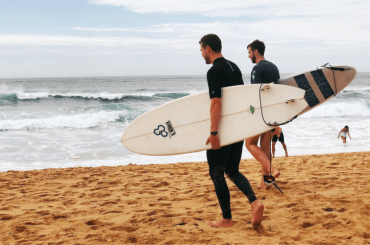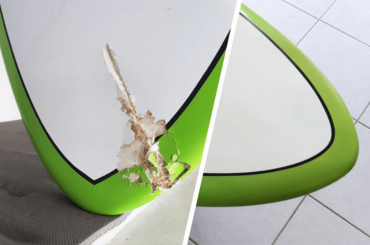Looking to buy a new surfboard and not sure what fins to go for? In this guide, we’ll take you through everything you need to know about surfboard fins so you can make the right choice for your next board.
We’ll discuss the different types of fins and their benefits, as well as how to choose the right size and shape for your surfing style.
So whether you’re a beginner or an experienced surfer, read on to learn more about surfboard fins!
Surfboard Fins | A Complete Guide
Surfboard fins are small, pointed pieces of plastic or fiberglass that stick out from the bottom of your board. They provide stability and control while you’re surfing and can help you turn and maneuver your board more easily.
There are a variety of different fin designs on the market, so you can experiment to find the ones that work best for your surfing style.
Surfboard fins are responsible for a lot when it comes to riding a wave. They help with speed and maneuverability and most importantly, they keep you stable on your board.
Fins also play a big role in how sharp you can turn your board. A lot of times, new surfers will have a hard time keeping their balance on the board and will end up wiping out.
Benefits of Using a Good Set of Fins
The following are the benefits of having good fins on your surfboard:
- Speed: Fins help in generating speed and also provide better tracking.
- Maneuverability: With the help of fins, you can make sharp turns and catch waves more easily.
- Stability: Fins add stability to your board and help you stay balanced while surfing.
- Sharp turns: As we mentioned before, fins play a big role in how sharp you can turn your board. With good fins, you’ll be able to make tighter turns and carve better on the wave.
- Catching waves: Good fins will help you catch waves more easily and allow you to paddle into them with more speed.
- Generating speed: Fins help you generate speed by providing better tracking and stability on the wave.
- Tracking: Fins help your board track in a straight line while you’re surfing. This is especially important when you’re paddling out to catch a wave or riding on a long, open-face wave.
- Better performance: In general, good fins will help you surf better and allow you to progress your skills more quickly.
Also Read: Can You Surf With Eyelash Extensions?
How many types of fins are there and what are their uses?
There are three types of fins commonly used by swimmers: butterfly, backstroke and freestyle.
Each type of fin is designed to help the swimmer move more efficiently through the water and improve their speed.
1. Butterfly fins
Butterfly fins are the largest and most powerful type of fin, making them ideal for swimming long distances or in open water.
2. Backstroke fins
Backstroke fins are smaller and provide less power, but they help swimmers move more smoothly through the water and maintain their balance.
3. Freestyle fins
Freestyle fins are the smallest type of fin and are designed for speed rather than power. They can help swimmers move through the water more quickly and make turns with ease.
When choosing a pair of fins, it is important to consider the type of swimming you will be doing and your level of experience.
If you are a beginner, it is best to start with a pair of backstroke or freestyle fins. These will help you build up your strength and stamina without overpowering you.
If you are an experienced swimmer, you may want to try a pair of butterfly fins. These will give you the most power and help you swim longer distances with ease.
Swimming with fins is a great way to improve your speed, stamina and technique. Fins can help you swim faster and farther with less effort. They also make it easier to maintain good form and technique while swimming.
What materials are used in making surfboard fins?
There are a variety of materials used in surfboard fins, including plastic, fiberglass and carbon fiber.
Each material has its advantages and disadvantages, so it’s important to choose the right material for your needs.
- Plastic fins are the most affordable option, but they’re also the heaviest and least durable.
- Fiberglass fins are more expensive, but they’re lighter and more durable.
- Carbon fiber fins are the most expensive option, but they’re also the lightest and most durable.
When choosing surfboard fins, it’s important to consider your budget, the conditions you’ll be riding in and your personal preferences.
If you’re just starting, plastic fins are a good option. If you’re an experienced surfer who wants to ride in all kinds of conditions, carbon fiber fins are a good choice.
No matter what material you choose, make sure to get fins that are the right size for your surfboard. Fins that are too big or too small can affect your surfing performance.
Relevant Topic: How Do I Know If My Surfboard Is Waterlogged?
How to determine the size and shape of the fin for your surfboard?
The first thing you need to do is to determine the type of waves you will be riding. Surfboards come in a variety of shapes and sizes and each one is designed for different types of waves.
For example: Shortboards are designed for riding in small, weak waves while longboards are better suited for larger, more powerful waves.
Once you know the type of waves you’ll be riding, you can start to narrow down the size and shape of the fin for your surfboard.
Generally, shorter boards need smaller fins and vice versa. The width of the fin is also important; too wide and it will make turning difficult, but too narrow and it will make the board unstable.
There are a few other factors to consider when choosing the size and shape of the fin for your surfboard.
For example: If you’re a big wave rider, you’ll need a bigger fin to provide more stability. If you’re a beginner, you might want to start with a smaller fin to make learning easier. Ultimately, it’s up to you to experiment and find what works best for you.
How to install a new fin on your surfboard?
Installing a new fin on your surfboard is a simple process that anyone can do. All you need is a screwdriver and a few minutes.
- First, remove the old fin from your board. You’ll need to unscrew the screws that hold it in place. Once the screws are removed, the fin should come right off.
- Next, line up the new fin with the holes in your board. Once it’s in place, screw in the screws to secure it.
- Make sure they’re tight so the fin doesn’t come loose while you’re riding.
That’s it! You’re now ready to hit the waves with your new fin.
Tips for choosing the right fins for your surfing style
There are a few things to keep in mind when choosing fins for your surfing.
- Consider the waves you’ll be riding. If you’re a beginner, you might want to start with smaller fins to make learning easier. If you’re an experienced surfer, you can choose either large or small fins depending on your preferences.
- Consider your surfing style. If you’re a big wave rider, you’ll need a bigger fin to provide more stability. If you’re a racer, you might want a smaller fin to help you go faster.
- Finally, consider the conditions you’ll be riding in. If you’ll be surfing in rough waters, you’ll need a durable fin that can withstand the elements. If you’ll be surfing in calm waters, you can choose a lighter fin that’s easier to maneuver.
No matter what your surfing style or ability, there’s a fin out there that’s perfect for you. So get out there and start riding the waves!
Why are surfboard fins so expensive?
There are a few reasons why surfboard fins can be expensive.
- First, they’re made from high-quality materials that can withstand the elements and provide superior performance.
- Second, they’re often custom-made to fit a specific board. And finally, they’re just plain cool!
If you’re looking for the best performance, you’ll need to be willing to pay a bit more for your fins. But if you’re just starting, there are plenty of affordable options that will still provide great performance.
So don’t let the price tag deter you from getting the perfect set of fins for your surfboard.
Topic To Read: How To Glass A Surfboard?
FAQs – Surfboard fins guide
How many fins are best for a surfboard?
The number of fins you’ll need for your surfboard depends on the type of waves you’re riding.
If you’re a beginner, you might want to start with a three-fin setup. This will provide stability and easy maneuverability.
If you’re an experienced surfer, you can experiment with different fin setups to find what works best for you. For example, a four-fin setup can provide more control in big waves.
Ultimately, it’s up to you to experiment and find what works best for you. So get out there and start riding the waves!
Are twin fins good for beginners?
Twin fins are a great option for beginners because they provide stability and easy maneuverability. With two fins, you’ll have an easier time keeping your board on course and riding the waves.
Is a twin fin faster than a single fin?
A twin fin is generally faster than a single fin because it provides more surface area for propulsion. However, it’s important to keep in mind that the type of waves you’re riding will also affect your speed. So if you’re looking to go fast, make sure you’re choosing the right waves!
Are twin fins good for small waves?
Twin fins are a great option for small waves because they provide stability and easy maneuverability. With two fins, you’ll have an easier time keeping your board on course and riding the waves.
Do fins help you catch waves?
Fins can help you catch waves. By providing stability and easy maneuverability, they’ll make it easier for you to paddle into the wave and catch a ride.
So if you’re looking to catch more waves, make sure you’ve got a good set of fins on your board!
Wrap Up
Fins provide stability and drive for a surfer when paddling out, help the board turn when carving and also act as brakes when needed. With all these important functions, it’s no wonder that surfers are particular about their fins.
And while there is no “perfect” fin setup, by understanding the different types of fins available and how they work, you can find the best fins for your surfing style.
With this guide, you should be able to find the perfect set of fins for your board and start shredding some serious waves. So get out there and enjoy the ride!





